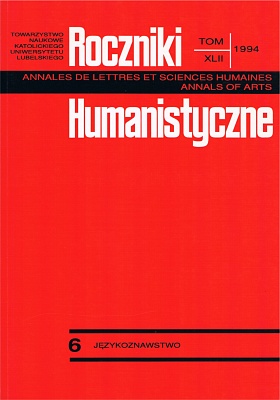Siemiginów
Abstract
The name Siemiginów concerning the place in the Stryj region o f the former Przemyśl district was discussed in detail in two studies: by J. Rudnicki in 1937, and by H. Safarewiczowa in 1971 in connection with her analysis o f the surname Siemiginowski. The solutions o f the toponym’s etymology presented in both these studies need to be corrected.
Having established the correct initial form o f the name as Semyhynov → Semyhyniv J. Rudnicki explains it wrongly as a possessive case ending in -iv ← ov from the basic form *Semyhyn, consisting of the element semy ← semja (//simja) ← proto-Slavonic *sĕmьja and of hyn: hunuty ← proto-Slavonic *gybnoti. The incorrect phonetic form of the first element with e instead of i ← proto-Slavonic *ĕ and the isolated – against the background of the Slavonic toponomy – character of the other component of the name -hyn ← proto-Slavonic *gy(b)n – are the weak points of Rudnicki’s argument.
H. Safarewiczowa wrongly assuming the Ukrainian form *Semihonov → Semihiniv - against the more complete philological records – as the initial one, explains it as physiographic one ending in -ov formed from the base *semihon → *semyhin. This would be a compound consisting of the numeral element sem → sim 'seven' and the substantival one hon → hin „flow, stream” whose joint meaning would be 'area through which a river flows in seven (=many) streams '. However, reservations are aroused by the phonetic shape of the derivative Semyhiniv and not *Semyhoniv (where it is impossible for the o to be shifted to an i) which forces one to question the presence of the hin ← hon in it.
Accepting as the initial one the form which was established by J. Rudnicki and which is consistent with the complete philological record: Semihynov → Semihyniv, one should explain the name as a physiographic one ending in -ov formed from the base semihyn, consisting of the adverbial element formed from the numeral semi ← semju 'seven times ’ – cf. Polish composita like czystopis, głodomór, wodotrysk. This exocentric construction would mean 'the river (Stryj) disappearing (in the swamps, turning, dividing and joining) seven (=many) times'.
The physiographical situation in the area confirms such an interpretation. Various forms with a similar hydrographic meaning like Sinewódzko, (perhaps Skole), Schodnica, Stuposiany, Rosocha(-y), Rosochaty, Rososze, Roz(s-)toka(-ki) would constitute a close and farther toponymic context for the name understood in this way.
Copyright (c) 1994 Roczniki Humanistyczne

This work is licensed under a Creative Commons Attribution-NonCommercial-NoDerivatives 4.0 International License.





